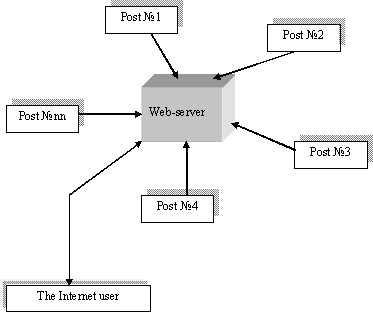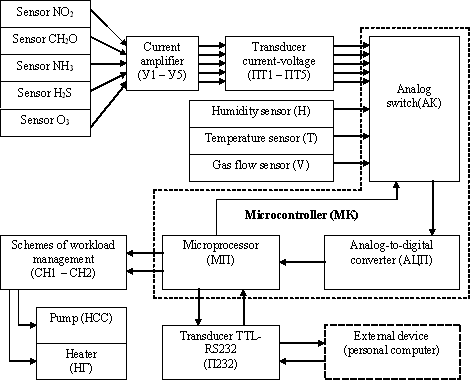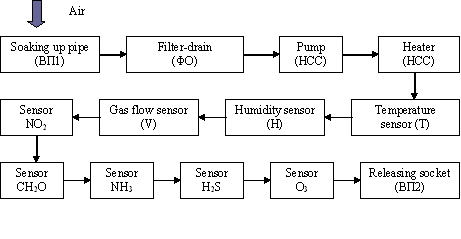


Faculty of Computers and Information Science
Speciality: Computer Monitoring Systems
 |
 |
Donetsk region is one of the most populated, economically potential and richest in natural resources area of Ukraine. It has one fifth of the industrial potential of the state. It has about 1.5 thousand major industrial enterprises of the key country industries: mining, metallurgical, chemical, machine-building, power and building.
Most of the major industrial enterprises of the region are ecologically dangerous objects. According to the data of the State statistics committee Donetsk region has 34% of the general amount of pollution from stationary sources. General amount of emission of harmful substances in 2007 made 1654 thousand tons [1].
The conclusion we can draw from the current situation is that in Donetsk region it is necessary to create the automatic system of ecological monitoring allowing not only to watch but also to predict the levels of atmosphere pollution.
The aim of my master’s degree work is to develop the automated system of atmosphere pollution monitoring, which allows to carry out automatic control of air condition on the local level, show and present information with the help of Web-technologies.
The tasks of my master’s degree work:
The supposed scientific novelty is in the following:
The results of the research on automatic data collection from remote sensors were reported at the international conference “Computer monitoring and information technologies” (KMIT-2009). The topic of the report was “Development and application of wireless communication systems for measurement of the atmosphere parameters”.
The automated monitoring system of the air pollution includes the following components:
There may be unlimited number of automatic posts. To connect with Web-server standard types of the Internet connections are used (fig.1).

The main measurement device of the automated system is the gas analyzer. It is an important component, because the gas analyzer determines the concentration of harmful substances in the atmosphere.
The main requirements to the gas analyzer are:
Before the beginning of gas analyzer development there were analyzed 3 most common methods of analysis of air substances contents:
Every of the above mentioned methods has its advantages and disadvantages. For example, in chemiluminescent sensors substrate with the composition solution must be changed once in two days or in 2 weeks (depends on the analyzed substance). For constant control without a man it is not suitable. Atomic emission spectroscopy presupposes either very bulky devices, or compact, but extremely expensive and complicated equipment.
That’s why to develop a gas analyzer electrochemical sensors were chosen. The used sensors are produced in lots by a Swiss company Membrapor [2]. The main sensors characteristics are given in table 1.
| Sensor | Substance | Concentration (ppm) | Concentration (mg/m3) |
| NO2/M-20 | Nitrogen dioxide (NO2) | 0 - 20 | 0 - 37 |
| NH3/CR-200 | Ammonia (NH3) | 0 - 100 | 0 - 71 |
| CH2O/M-10 | Formaldehyde (CH2O) | 0 - 10 | 0 - 12 |
| H2S/M-50 | Hydrogen sulfide (H2S) | 0 - 50 | 0 - 71 |
| O2/M-5 | Ozone (O3) | 0 - 5 | 0 - 10 |
Based on technical characteristics of sensors provided by the producer it is possible to conclude that these sensors are quite acceptable for a gas analyzer development. Moreover the sensors producer carries out sensors control and gives a corresponding certificate.
Construction of the gas analyzer consists of two technical systems – electronic and air-gas.
Figure 2 presents a structural flow chart of the gas analyzer electronic system.

Figure 3 presents the structural flow-chart of the air-gas system.

The first experimental model of a gas analyzer is called AIRHACKER-1.
The gas analyzer is a device for measuring nitrogen dioxide, hydrogen sulphide, formaldehyde, ammonia and ozone concentration in the air. It displays the data on an LCD and transmits the data through the serial port (RS-232, RS-485 or USB) into the computer.
Main technical characteristics:
Conditions of operation:
Electrical characteristics:
Physical specifications:
At present the software which reads data from industrially produced gas analyzers CM-NO2-SO2-CO and weather stations DAVIS Vantage PRO is being tested [3]. The program to control the gas analyzer is written in the programming language Borland Delphi 7.0. It includes several modules:
Figure 4 presents a screen-shot of the program for reading data from gas analyzer and weather station.

Remote Web-server consists of 2 components:
Hardware subsystem is a computer connected to the internet via modem or any other device. It does not matter where in fact hardware of the Web-server is situated. It can be either any computer at university or a server of internet-provider in the USA. The important thing is that it must have access from outside via the Internet.
Upper level software is a component of the software of automated monitoring system and its structure and algorithms are determined by tasks and functions of the processing system, storing and keeping information.
Upper level software operation is provided by the following software components:
Upper level software provides processing, storing and presenting of information. To fulfill this function the following software functions are defined:
Realization of these functions will allow to fulfill the task of processing, storage and presenting of information.
At present the resource ÀÊÈÀÌ is used, which was specially designed to combine automated data collecting posts. It also presupposes manual data setting [4]. Figure 5 shows the table of current measurements, constantly updated by automated post ¹6.

Realization of the following stages is planned in future:
Analysis of the data and current data collecting, storing and processing systems in Donetsk allows to characterize the working systems of ecological monitoring as not conforming to modern conditions and requirements.
In this connection analysis of the information allows to conclude the following:
That is why it is necessary to design a new automated system of the atmosphere pollution monitoring suitable for Ukrainian market, which is cheap and reliable, able to carry out continuous automatic control for at least 2 years.
The master’s work was not completed yet while writing this abstract of thesis. The date of completing is 1 December, 2009. The full text of the work and the material on this subject can be received from the author or its curator after the given date.